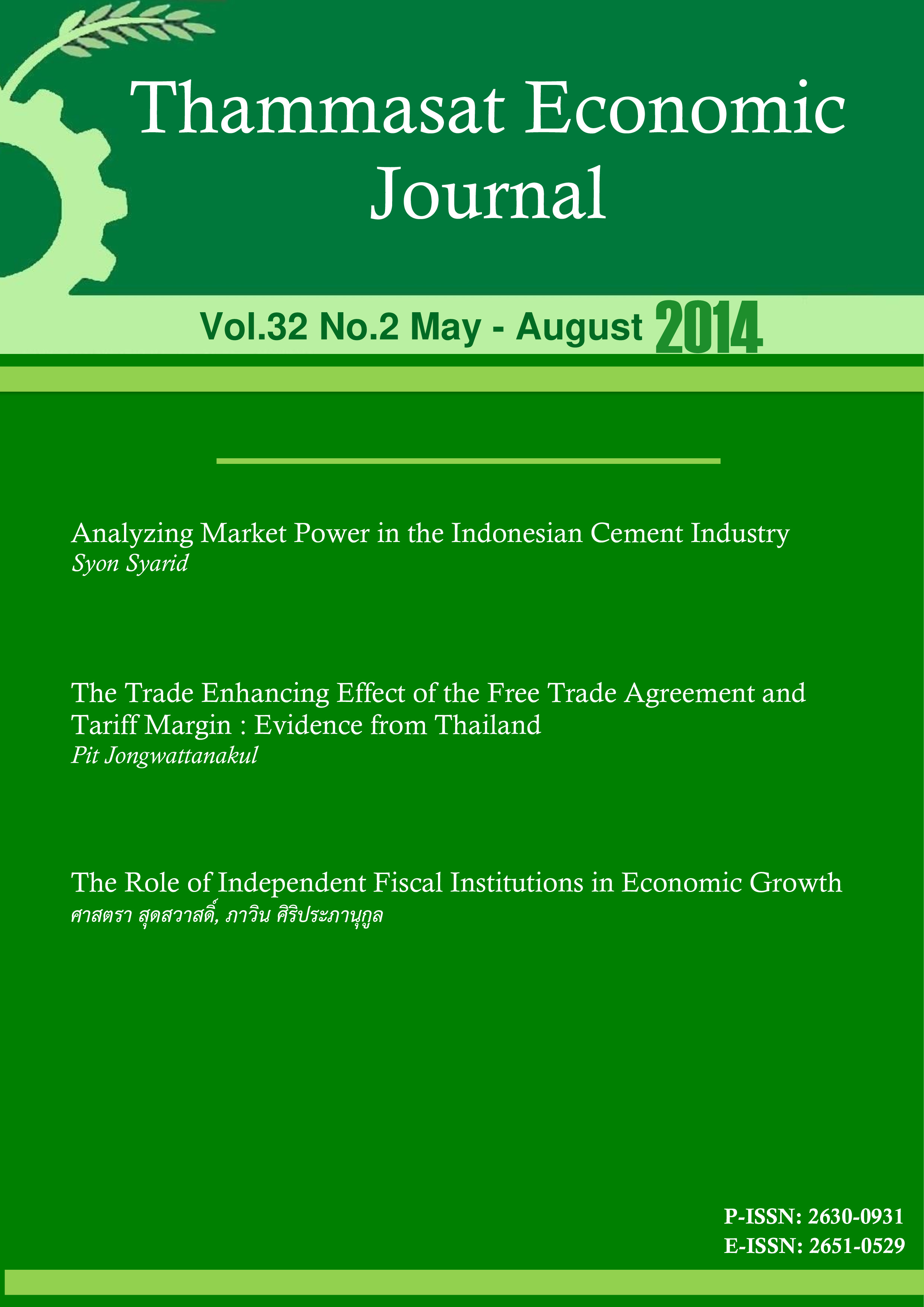Analyzing Market Power in the Indonesian Cement Industry
Keywords:
error correction model, non-stationary, integration test, co-integration test, weakly exogenous, separability test, the Indonesian cement industryAbstract
This paper aims to analyze market power in the Indonesian cement industry during the period of 1993-2011. The model used to estimate the degree of market power is Bresnahan-Lau’s model proposed by Bresnahan (1982) and supported by Lau (1982). This model allows the estimation of market power using the demand and supply function although the marginal cost data in an industry is unavailable. This model would be later reformulated into a dynamic model of error correction model (ECM) framework. The ECM framework adopted here is more based on the theoretical framework because this model could address both statistical problems generated by non-stationary in a time series data and incorporates the important dynamic factors such as habit formation from the demand side and adjustment cost for the producers. In addition, the result of the ECM framework also enables us to analyze the degree of competition in the short and long run equilibrium conditions. Separability test of the variables involving the identification of the degree market power as well as preliminary test such as integration test, co-integration test, and weakly exogenous test is also performed in this paper. The result suggests that the Indonesian cement has some market power of oligopolistic competition both in the short run and in the long run.
References
2.Banerjee, Anindya, Dolado, Juan J, Galbraith, Hohn W & Hendry, David F (1993), Co-Integration, Error Correction Model, And The Econometric Analysis of Non-Stationary Data, Oxford University Press, New York.
3.Boef, Suzanna De (2000), Modeling Equilibrium Relationships: Error Correction Models with Strongly Autoregressive Data, Political Analysis, Vol. 19, No.1.
4.Boef, Suzanna De & Keele, Luke (2008), Taking Time Seriously, American Journal of Political Science, Vol. 52, No.1, 184-200.
5.Bresnahan, Timothy F (1982), the Oligopoly Solution Concept Is Identified, Economics Letters 10: 87-92.
6.Bresnahan, Timothy F (1989), Empirical Studies of Industries with Market Power, Handbook of Industrial Organization, Editor: R. Schmalensee and R. Willig. Amsterdam: North-Holland, 1011–1057.
7.Chintrakarn, Pandej & Jindapon, Paan (2012), A Dynamic Analysis of Market Power in the US Mortgage Lending Market, European Journal of Scientific Research, Vol. 69, No. 2, 218-233.
8.Church, Jeffrey & Ware, Roger (2000), Industrial Organization: A Strategic Approach, International Edition, McGraw-Hill, USA.
9.Corts, Kenneth S (1999), Conduct Parameter and Measurement of Market Power, Journal of Econometrics, Vol. 88, 227-250.
10.Deodhar, Satish Y & Sheldon, Ian M (1997), Market Power in the World Market For Soymeal Exports, Journal of Agricultural and Resource Economics, Vol. 22, 78-86.
11.Dowling, Jhon Malcolm (2006), Competition Policy in Indonesia, Working Paper Series, SMU Economics and Statistics, Singapore.
12.Friedman, James W (1983), Oligopoly Theory, Cambridge University Press, Cambridge, New York.
13.Genesove, David & Mullin, Wallace P (1998), Testing Oligopoly Models: Conduct and Cost in the Sugar Industry, the RAND Journal of Economics, Vol. 2.
14.Gupta, G.S & Patel, Kirit (1976), Location of Indian Cement Industry, Vikalpa, Vol.1, No.4.
15.Hausman, Jerry A & Sidak, J. Gregory (2007), Evaluating Market Power Using Competitive Benchmark Prices Instead of the Herfindahl-Hirschman Index, Antitrust Law Journal, Vol.74.
16.Hjalmarsson, Erik (2000), Nord Pool: A Market Power without Market Power, Working Papers in Economics, No.28, Department of Economics, Goteborg University, Sweden.
17.Indonesian Commercial Newsletter (2006), Monthly Report, PT. Data Consult, Business Survey and Report, Indonesia.
18.Ivaldi, March; Jullien, Bruno; Rey, Patrick; Seabright, Paul; Tirole, Jean (2003), The Economics of Tacit Collusion, Final Report for DG Competition, European Commission, IDEI Toulouse.
19.Johansen, Soren (1988), Statistical Analysis of Co-Integration Vector, Journal of Econometric Dynamics and Control, Vol. 12, 231-254.
20.Johansen, Soren & Juselius, Katarina (1990), Maximum Likelihood Estimation and Inference on Co-Integration with Application to the Demand for Money, Oxford Bulletin of Economics and Statistics, Vol. 52, No.2.
21.Kuenne, Robert E (1992), the Economics of Oligopolistic Competition, Blackwell Publisher, Cambridge, USA.
22.Kutlu, Levent & Sickles, Robin C (2011), Estimation of Market Power in The Presence of Firm Level Inefficiencies, Journal of Econometrics, Vol. 168, 141-155.
23.Landes, William M & Posner, Richard A, Market Power in Antitrust Cases, Harvard Law Reviews, Vol. 94, 937-996.
24.Lau, Lawrence (1982), On Indentifying the Degree of Competitiveness from Industry Price and Output Data, Economics Letter, 10: 93-99.
25.Mabry, James C (1998), Regulation, Industry Structure, and Competitiveness in the U.S. Portland cement Industry, Business and Economics History, Vol. 27, No. 2.
26.Martin, Stephen (1994), Industrial Economics: Economic Analysis and Public Policy, Second Edition, Macmillan Maxwell, New York.
27.Nusa Prima Persada International Consulting (2010), Update on the Cement Industry in Indonesia-July 2010, Indonesia.
28.Plunkett, H.J., Morgan, W.E. & Pameroy, J.L. (1997), Regulation of the Indonesian Cement Industry, Bulletin of Indonesian Economics Studies, Vol. 33, No. 1, 75-102.
29.Steen, Frode& Salvanes, Kjell G (1999), Testing for Market Power Using a Dynamic Oligopoly Model, International Journal of Industrial Organization, Vol. 17, 147-177.
30.Vassilopoulos, Philippe (2003), Model for the Identification of Market Power in Wholesale Electricity Market, D.E.A 129, Industrial organization, CGEMP, Universite Paris Dauphine.










